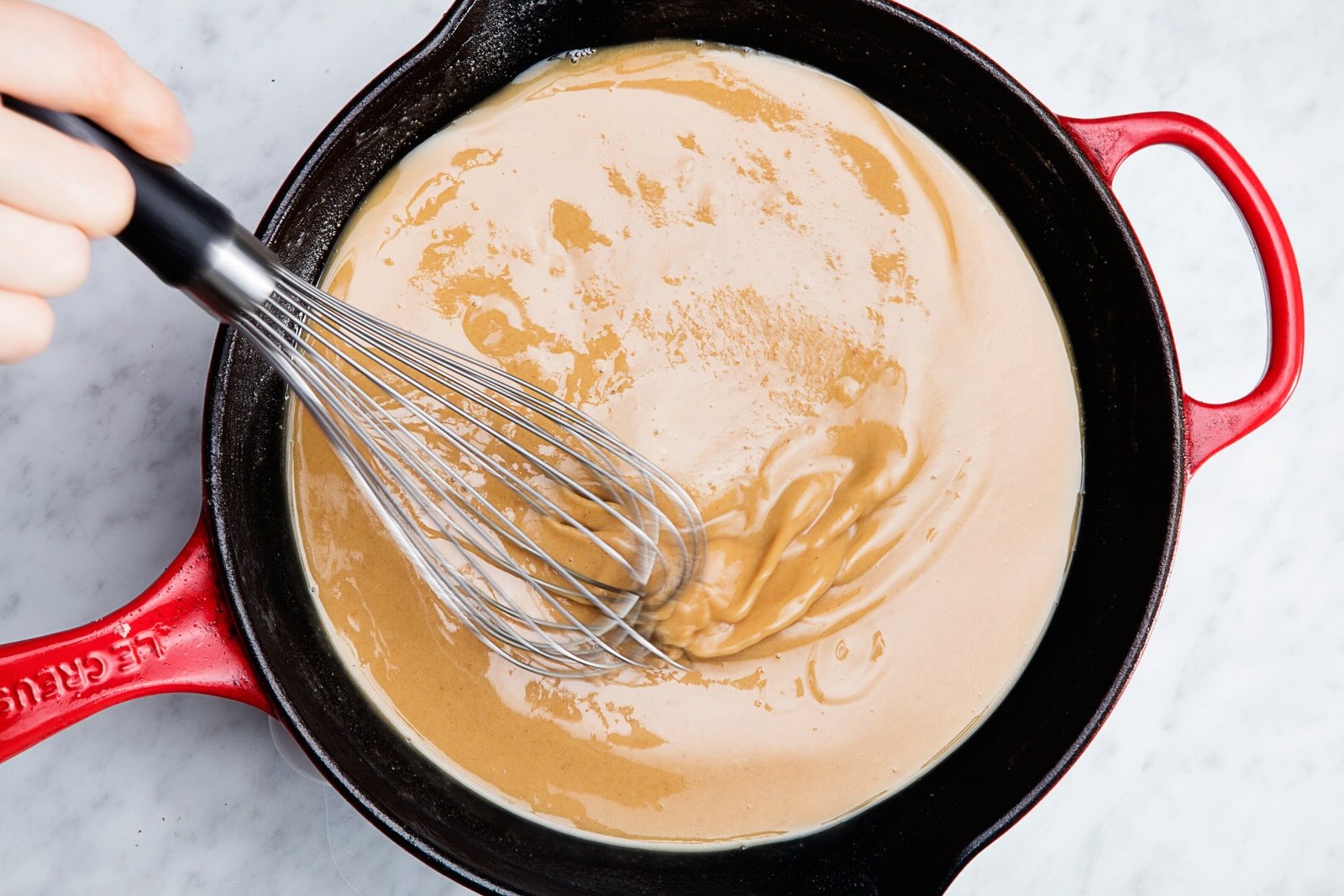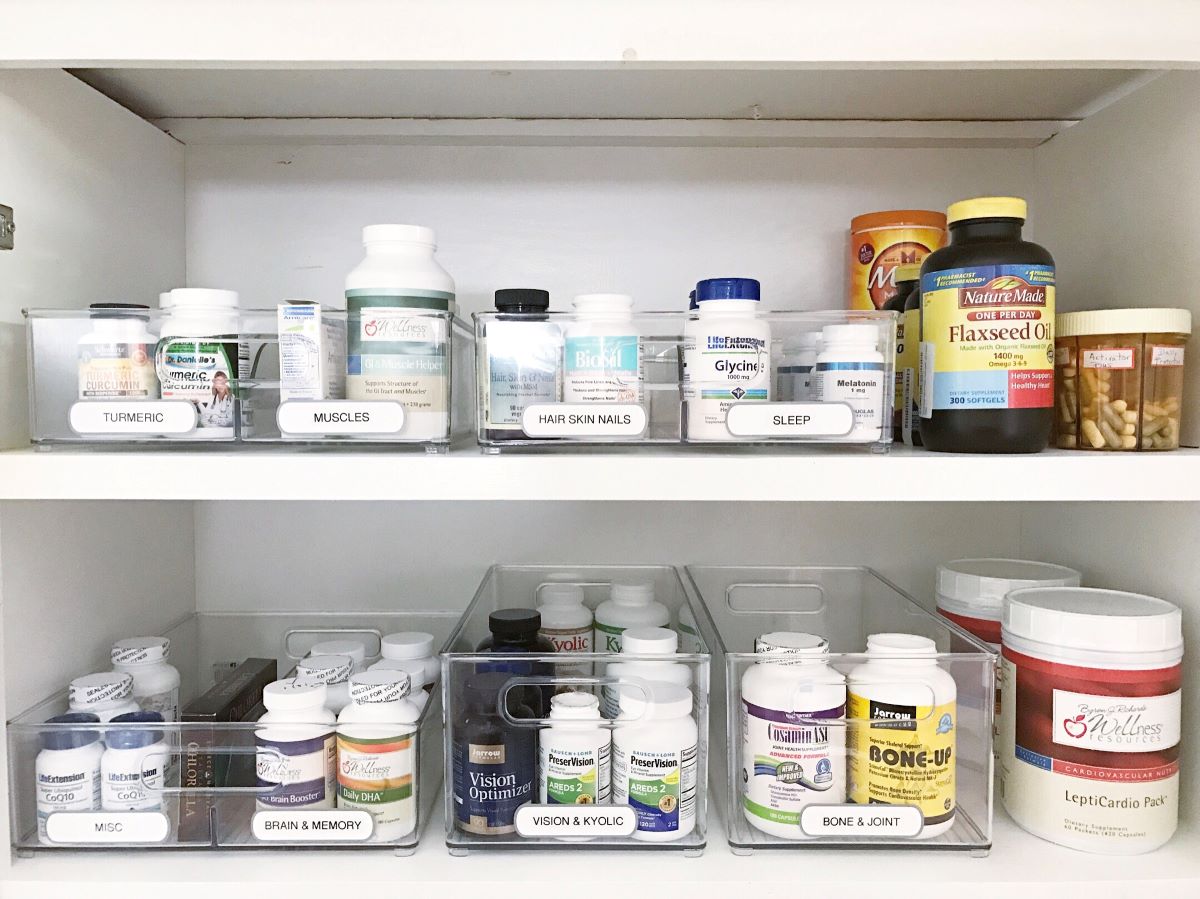

Articles
How To Store Roux
Modified: October 20, 2024
Learn the best way to store roux with our helpful articles. Keep your roux fresh and flavorful for all your cooking needs.
(Many of the links in this article redirect to a specific reviewed product. Your purchase of these products through affiliate links helps to generate commission for Storables.com, at no extra cost. Learn more)
Introduction
When it comes to cooking, many recipes call for the use of roux. Whether you’re making a classic French sauce, a hearty gumbo, or a comforting macaroni and cheese, roux is often a key ingredient that adds depth and flavor to dishes. But what happens when you have leftover roux? How do you store it properly to ensure its freshness and usability? That’s exactly what we’ll be exploring in this article.
Before we delve into the storage techniques, let’s first understand what roux is. Roux is a mixture of flour and fat, typically butter or oil, cooked together to form a thickening agent. It serves as the base for many sauces, soups, and stews, providing a smooth and velvety texture. The color of the roux can range from white to a deep brown, depending on the cooking time and the desired flavor profile.
Proper storage of roux is crucial to maintain its quality and prevent it from spoiling. If not stored correctly, roux can develop a rancid flavor or become a breeding ground for bacteria. Additionally, storing roux improperly can result in a loss of its thickening power, leading to disappointing culinary outcomes.
There are several factors to consider when storing roux, such as temperature, container type, and duration. By taking these factors into account, you can ensure that your roux remains fresh and ready to be used whenever you need it.
Key Takeaways:
- Properly storing roux is crucial to maintain its quality, flavor, and thickening power. Consider temperature, container type, and duration to ensure freshness and avoid wastage.
- Cool, portion, and label roux before storing in airtight containers. Thaw and reheat properly for efficient use in future recipes. Avoid room temperature storage and reuse.
Read more: How To Store Store-Bought Bread
What is Roux?
Roux is a fundamental component in the culinary world, commonly used as a thickening agent for sauces, soups, and stews. It is made by combining equal parts flour and fat, typically butter or oil, and cooking them together until they form a smooth paste.
The process of cooking roux involves heating the fat in a pan and gradually whisking in the flour. The mixture is then cooked over medium heat, stirring constantly, until it reaches the desired color and consistency. The cooking time can vary depending on the desired flavor profile, with shorter cooking times producing lighter roux and longer cooking times resulting in darker roux.
The color of the roux determines its flavor and thickening power. A white or blonde roux has a subtle flavor and is often used in delicate sauces and creamy dishes. It has a mild thickening ability and lends a slightly nutty taste to the final dish.
As roux cooks for a longer duration, it develops a deeper color and a more pronounced flavor. This is known as a brown or dark roux, commonly used in hearty Cajun and Creole dishes. Brown roux has a rich, toasty flavor and a higher thickening power, perfect for gumbo, jambalaya, and étouffée.
Roux acts as a binding agent, helping to thicken and stabilize sauces and other liquid-based dishes. The flour in roux absorbs the fats, creating a smooth and homogeneous mixture. When added to a hot liquid, the roux disperses evenly, creating a velvety texture and a luscious mouthfeel.
Not only does roux thicken sauces, but it also helps to enhance the flavors of the ingredients. It acts as a flavor carrier, allowing the aromas and tastes of herbs, spices, and other ingredients to meld together harmoniously.
Now that we have a better understanding of what roux is and its importance in cooking, let’s move on to the next section and explore why proper storage of roux is crucial.
Why is Proper Storage of Roux Important?
Proper storage of roux is essential for maintaining its quality, flavor, and thickening power. Here are a few reasons why it is important to store roux correctly:
- Preserving Flavor: Roux contains both fat and flour, which can easily go rancid if not stored properly. Storing roux in airtight containers and in the right conditions helps to prevent the oxidation of fats and maintain the integrity of the flavors. This ensures that your roux stays fresh and doesn’t develop any off-putting tastes.
- Preventing Bacterial Growth: Moisture and warmth can create an environment where bacteria thrive. Storing roux in a cool and dry place, such as the refrigerator, minimizes the risk of bacterial growth. This helps to keep your roux safe to use and prolong its shelf life.
- Maintaining Thickening Power: Over time, roux can lose its thickening ability if not stored properly. Improper storage can lead to moisture absorption, causing the flour particles to clump together and lose their ability to thicken liquids. By storing roux correctly, you can ensure that it retains its thickening power and helps create the desired consistency in your recipes.
- Cost Savings: Roux is often made in larger batches, not all of which may be used immediately. By storing roux properly, you can extend its shelf life and avoid wastage. This can help you save money by ensuring that you can use the roux in future recipes without the need to discard any leftovers.
- Efficiency in Cooking: Having stored roux readily available allows for quicker preparation of sauces and dishes. Instead of making roux from scratch every time you need it, you can simply thaw or reheat the stored roux and incorporate it into your recipes. This saves time and effort in the kitchen.
Proper storage practices for roux ensure that you have a fresh and reliable ingredient whenever you need it. Now that we understand the importance of storing roux correctly, let’s move on to the next section and explore the factors to consider when storing roux.
Factors to Consider for Storing Roux
When it comes to storing roux, several factors need to be taken into consideration to ensure its longevity and quality. Here are the key factors to keep in mind:
- Temperature: Keeping roux at the right temperature is crucial. It is best to store roux in a cool environment to minimize the risk of spoilage. The ideal temperature range for storing roux is between 35°F (1.7°C) and 40°F (4.4°C), which is typically the temperature range of most refrigerators. A cool temperature helps preserve the freshness and flavors of the roux.
- Container Type: Choosing the proper container for storing roux is important. Opt for airtight containers that are specifically designed for food storage. These containers help to prevent air and moisture from entering, which can cause the roux to spoil or lose its quality. Glass jars with tight-fitting lids or plastic containers with secure seals are good options.
- Duration: Roux can be stored for several weeks or even months, depending on the storage conditions. Take note of the date when you made or purchased the roux and label the container accordingly. Aim to use the roux within a reasonable time frame to ensure its freshness and optimal quality. It is recommended to use roux within 3-6 months for the best results.
- Thawing and Reheating: If you store roux in the freezer, it is important to plan ahead when you need to use it. When it’s time to use the stored roux, thaw it in the refrigerator overnight or use the defrost function on your microwave for a quicker thaw. Do not thaw roux at room temperature, as this can encourage bacterial growth. Once thawed, you can reheat the roux on the stovetop or in the microwave before incorporating it into your recipe.
By considering these factors, you can ensure that your stored roux maintains its quality, flavor, and thickening power. In the next section, we will provide a step-by-step guide on how to store roux effectively.
Step-by-Step Guide on How to Store Roux
Storing roux properly is essential for preserving its quality and extending its shelf life. Here is a step-by-step guide on how to store roux effectively:
- Cool the Roux: Allow the cooked roux to cool completely before transferring it to a storage container. This prevents condensation from forming inside the container, which can lead to moisture buildup and spoilage.
- Select the Right Container: Choose airtight containers that are specifically designed for food storage. Glass jars with tight-fitting lids or plastic containers with secure seals are excellent options. Make sure the container is clean and dry to maintain the freshness of the roux.
- Portion the Roux: Divide the roux into smaller portions before storing. This allows you to thaw only the amount you need for a particular recipe without having to thaw the entire batch. Consider portioning the roux based on the average amount required in your recipes, such as tablespoons or cups.
- Fill the Containers: Fill each container with the desired portion of roux, leaving some headspace to account for expansion during freezing or to prevent spillage. Be careful not to overfill, as the roux may expand when frozen.
- Seal the Containers: Ensure that the containers are tightly sealed to prevent air and moisture from entering. This helps to maintain the quality and flavor of the roux. Double-check the lids or seals to make sure they are secure.
- Label and Date: Label each container with the date of storage. This will help you keep track of the roux’s freshness and use it within a reasonable time frame. Include any necessary information, such as the type of roux (blonde or brown) or any additives used.
- Freeze or Refrigerate: Depending on your storage preference and the duration you plan to keep the roux, choose between freezing or refrigerating it. If you intend to use the roux within a few weeks, store it in the refrigerator. For longer-term storage, place the roux in the freezer.
- Thawing and Reheating: When you need to use the stored roux, transfer it from the freezer to the refrigerator overnight for gradual thawing. Alternatively, use the defrost function on your microwave for a quicker thaw. Once thawed, reheat the roux on the stovetop or in the microwave before incorporating it into your recipe.
By following these steps, you can store roux effectively, preserving its quality and flavors for future culinary adventures. In the next section, we will discuss the recommended storage containers for roux.
Store roux in an airtight container in the refrigerator for up to 1 week or in the freezer for up to 6 months. When ready to use, thaw frozen roux in the refrigerator before reheating.
Read more: How To Store Basil From Grocery Store
Recommended Storage Containers for Roux
Choosing the right storage containers for your roux is essential to maintain its freshness, prevent contamination, and ensure easy access. Here are some recommended storage containers for storing roux:
- Glass Jars: Glass jars with airtight lids are an excellent choice for storing roux. They are durable, easy to clean, and transparent, allowing you to easily see the contents. Look for jars with a secure seal to prevent air and moisture from entering. Mason jars are a popular option due to their reliable seal and wide-mouth opening, making it convenient to scoop out the desired quantity of roux.
- Plastic Containers: Food-grade plastic containers with tight-fitting lids are another reliable option for storing roux. Look for containers that are specifically designed for freezer storage, ensuring they are BPA-free and safe for long-term use. Plastic containers are lightweight, stackable, and easy to label, making them a practical choice for storing and organizing different portions of roux.
- Silicone Freezer Bags: Silicone freezer bags are a versatile option for storing roux. They are leak-proof, flexible, and space-efficient, as they can be laid flat in the freezer. Silicone bags are also reusable and easy to clean, making them environmentally friendly. Choose bags that are specifically designed for freezer use, as they are made with thicker, more durable materials to prevent leaks and protect the quality of the roux.
- Sealable Plastic Freezer Wraps: If you prefer a more economical option, sealable plastic freezer wraps can be used to store smaller portions of roux. These wraps can be folded and sealed tightly to keep air and moisture out. However, they may not provide as much protection as airtight containers or bags, so it’s essential to double-wrap for added security and prevent freezer burn.
- Vacuum Seal Bags or Systems: For maximum longevity and protection against freezer burn, consider using vacuum seal bags or systems. These bags remove the air from the packaging, creating a tight seal that preserves the quality of the roux for extended periods. Vacuum sealing also helps to prevent any possible odor transfer from the roux to other foods in the freezer.
Choose the storage container that suits your needs, whether it’s for convenience, space utilization, or long-term storage. Ensure that the containers are clean, dry, and airtight to maintain the freshness and quality of the roux. In the next section, we will provide some tips for maintaining the quality of stored roux.
Tips for Maintaining the Quality of Stored Roux
To ensure that your stored roux remains fresh, flavorful, and ready to use, there are a few tips you can follow to maintain its quality:
- Proper Labeling: Clearly label each storage container with the date of storage and any relevant information. This will help you keep track of the freshness of the roux and ensure that you use it within a reasonable time frame.
- Airtight Storage: Whether using glass jars, plastic containers, silicone bags, or vacuum-sealed bags, always make sure that the storage containers are airtight. This prevents air and moisture from entering and affecting the flavor and quality of the roux.
- Avoid Frequent Thawing and Refreezing: When using stored roux, try to thaw only the amount needed for a particular recipe to minimize the need for repeated thawing and refreezing. Continual temperature fluctuations can affect the texture and quality of the roux over time.
- Use Clean Utensils: When scooping roux out of the storage container, use clean utensils to prevent cross-contamination. Avoid using hands or utensils that have been in contact with raw or contaminated ingredients, as this can introduce bacteria to the stored roux.
- Proper Thawing: Thaw frozen roux in the refrigerator overnight or use the defrost function on your microwave for a quicker thaw. Avoid thawing roux at room temperature, as this can promote bacterial growth. Remember to reheat the thawed roux before incorporating it into your recipe.
- Maintain Consistent Temperature: If storing roux in the refrigerator, ensure the temperature is set between 35°F (1.7°C) and 40°F (4.4°C). Keep the temperature consistent to prevent temperature fluctuations that may affect the quality and longevity of the roux.
- Inspect for Spoilage: Before using stored roux, always inspect it for any signs of spoilage, such as an unusual odor, mold growth, or discoloration. If any of these signs are present, discard the roux to avoid any potential health risks.
Following these tips will help you maintain the quality and flavor of your stored roux, ensuring that it continues to enhance your culinary creations. In the next section, we will address some frequently asked questions about storing roux.
Frequently Asked Questions (FAQs)
Here are some common questions about storing roux:
- Can you freeze roux?
- How long can you store roux?
- Can you store roux at room temperature?
- Can you store different types of roux together?
- Can you reuse stored roux?
- What are the signs of spoiled roux?
- Can you store roux in the pantry?
Yes, you can freeze roux to extend its shelf life. Freezing roux is a convenient option if you want to store it for longer periods. Just make sure to transfer the cooled roux into a freezer-safe container or bag, label it, and place it in the freezer.
Roux can be stored for several weeks in the refrigerator or 3-6 months in the freezer. However, it’s best to use the roux within a reasonable time frame to maintain its quality and flavor.
It is not recommended to store roux at room temperature, as it can promote bacterial growth and spoilage. It is best to store roux in the refrigerator or freezer for optimal freshness and safety.
It is generally recommended to store different types of roux separately. This is because the flavors and colors of different roux variations may blend and affect the overall taste and appearance. It is best to store blonde and brown roux in separate containers.
It is not recommended to reuse stored roux once it has been thawed and reheated. The quality and texture of the roux can be altered during the freezing and thawing process, affecting its thickening power and overall performance. It is best to use the stored roux in one go and avoid reusing leftovers.
If stored roux develops an off smell, mold growth, or unusual discoloration, it is likely spoiled and should be discarded. These are signs of bacterial growth or deterioration, and consuming spoiled roux can pose health risks.
No, it is not advisable to store roux in the pantry. Roux contains fats that can go rancid at room temperature, and moisture in the pantry can cause the roux to spoil quickly. It is best to store roux in the refrigerator or freezer.
These are just a few common questions about storing roux. If you have any specific concerns or questions, it is always best to refer to your recipe’s instructions or consult a reliable source. In the next section, we will conclude our article.
Conclusion
Proper storage of roux is essential for maintaining its quality, flavor, and thickening power. By considering factors such as temperature, container type, and duration, you can ensure that your roux remains fresh and ready to use whenever you need it.
Roux, a mixture of flour and fat, is a versatile thickening agent used in a variety of dishes. Its flavors can range from subtle and delicate to rich and toasty, depending on the cooking time and color of the roux. Storing roux correctly preserves the integrity of these flavors and prevents it from developing a rancid taste or becoming a breeding ground for bacteria.
When storing roux, it is recommended to cool it completely before transferring it to airtight containers such as glass jars, plastic containers, silicone bags, or vacuum-sealed bags. Portioning the roux and labeling each container with the storage date helps you keep track of its freshness. Storing roux in the refrigerator or freezer, depending on your timeframe, helps maintain its quality and thickening power.
By following these storage guidelines and considering important factors, you can extend the shelf life of your roux and avoid wasting any leftovers. This can lead to cost savings and increased efficiency in your cooking processes.
Remember to thaw and reheat the stored roux properly before incorporating it into your recipes. It is crucial to maintain a consistent temperature and use clean utensils to prevent contamination.
With these tips and recommendations in mind, you can confidently store roux and enjoy its benefits in various dishes. Whether you’re whipping up a classic sauce, a comforting soup, or a flavorful stew, properly stored roux will be there to elevate your culinary creations.
Don’t let leftover or excess roux go to waste – store it correctly and embark on your culinary adventures with confidence!
Frequently Asked Questions about How To Store Roux
Was this page helpful?
At Storables.com, we guarantee accurate and reliable information. Our content, validated by Expert Board Contributors, is crafted following stringent Editorial Policies. We're committed to providing you with well-researched, expert-backed insights for all your informational needs.















0 thoughts on “How To Store Roux”